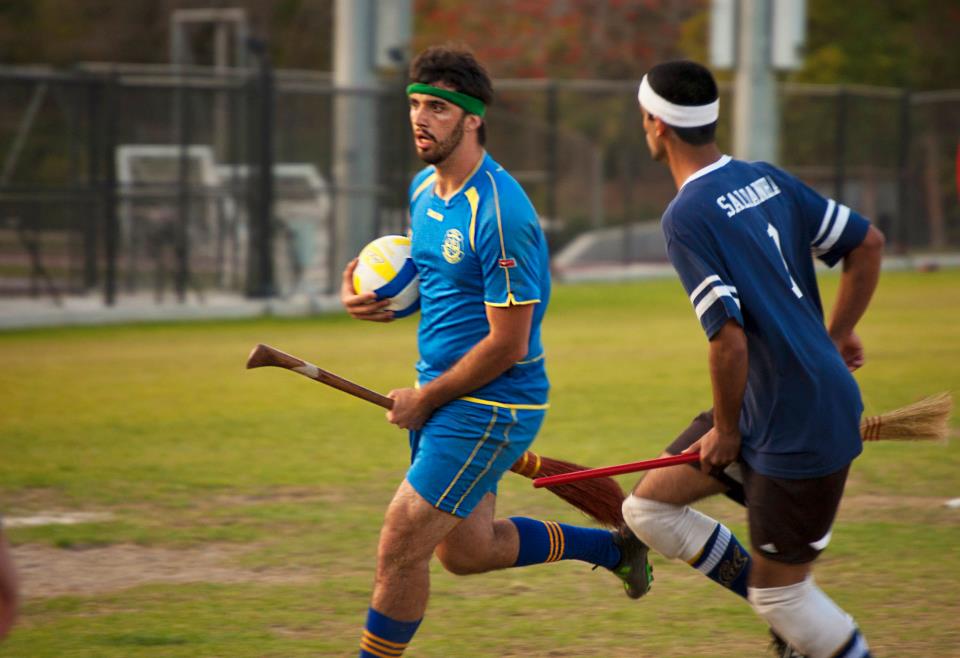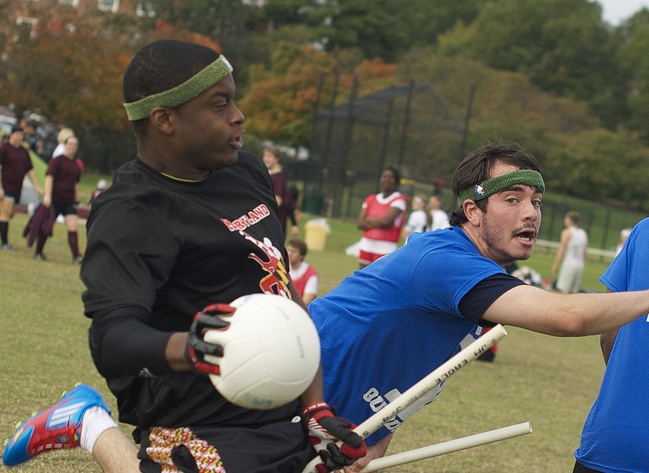- Rule, Britannia, no more?
- Unpopular Opinions: US Quadball Cup 2023
- Proven Contenders: University of Virginia
- Proven Contenders: Rutgers University
- Proven Contenders: University of Michigan
- Proven Contenders: Creighton University
- Different Perspectives: A Look Inside USA Ultimate
- Antwerp QC, Much of Belgian Core, Leaves Competitive Quidditch
The Offensive Keeper
- Updated: October 29, 2012


Many of the world’s top teams use their keepers, like UCLA’s Alex Browne (left), as an offensive threat. Credit: Kat Ignatova
The keeper position is often a draw for those that have played the equivalent in sports like soccer, ice hockey and water polo. But there’s one major difference between playing goalie in those sports and playing keeper in quidditch — offense. In other sports, keepers or goalies focus entirely on defense. In quidditch, the keeper also has the opportunity to act as an essential part of her team’s offense.
Inexperienced teams will often struggle at first to properly utilize the keeper on offense. But The Eighth Man is here to help, with five different roles that work the keeper into your offense.
Point Guard
In basketball, the point guard is usually the one who runs the offense, moving the ball up the floor and controlling how the ball is spread around. The keeper is well-suited to fill a similar role in quidditch. Since they typically don’t go all the way down the pitch on offense, they are the ideal person to work the quaffle up towards midfield.
Doing this also gives your team more options further down the pitch, and spreads the defense. If the keeper stays back while a chaser brings the ball up, there are only two passing options, both of whom can be covered by chasers. But the keeper has three options and forces the opposing keeper into more difficult decisions.
Defensive Lure
Due to the specific demands of the keeper position, most keepers are large, athletic players. Use that to your team’s advantage. Make the defense devote a beater, multiple defensive chasers, or their best defensive chaser to your keeper, freeing up space for your other scoring threats closer to the hoops.
If there is a defensive chaser who is completely shutting down your chasers, force them to come up and guard your keeper by having the keeper be aggressive consistently. While your keeper won’t necessarily be able to get past or run through that dominant defender, a keeper is also less likely to be completely tied up because of their size.
The most important factor here is that the keeper doesn’t pass before she needs to. If the keeper isn’t drawing enough defense to free up her teammates, she should continue to move forward until she can either shoot or does draw the necessary coverage.
Offensive Mismatch
If defenses don’t take extra precautions against your large, athletic keepers, make them pay for it. Sometimes defenses will try to stop a keeper with just one or two undersized chasers, which is often offering the offensive team a free goal, since running through smaller players is a skill that many keepers inherently have.
Teach your keepers to recognize physical mismatches and exploit them. Many new keepers will let the defender, even an undersized one, dictate the play, when the keeper herself should be in control. That being said, the decision can sometimes be more than meets the eye, and helping guide your keeper with scouting beforehand can help them make better decisions. Sure, many undersized players won’t be able to handle a keeper, but if she finds herself up against an elite defender, a pass may be necessary.
Fast Break Juggernaut
When a keeper blocks a shot or has an opportunity to quickly restart play, have her capitalize on it and take off down the field. This has the opportunity of catching the defense completely off guard, leading to 10 free points. Even if they can respond in time, forcing them to react so quickly creates defensive mismatches. They may be unable to get their best defender over to the correct side of the field in time, or might get caught with both of their beaters competing for bludgers far from their hoops.
During the IQA summer games, nearly every one of Team USA’s keepers was incredibly proficient at leading on fast breaks, and they were nearly unstoppable when they did so. This led to plenty of free points for the international games top team.
Long-Range Threat
If a defense knows that a particular keeper can routinely make shots from anywhere in the offensive half, they are forced to adjust, spreading themselves thin and leaving holes for chasers to slip into. It’s also an effective way to combat defenses that like to pack in close to the hoops with both their chasers and beaters and limit close shots.
When watching video of University of Maryland’s team, you quickly notice that James Hicks will regularly utilize long shots early in the game, successfully opening up space for the team’s dangerous chasers. There aren’t many things more dangerous.

